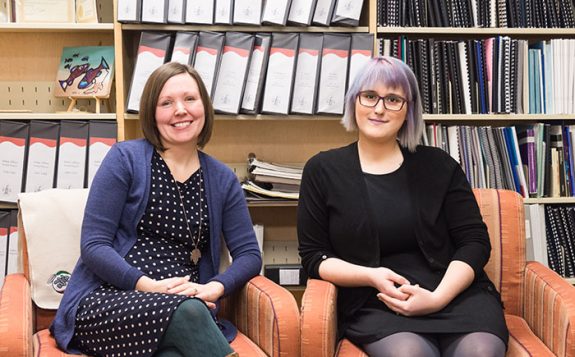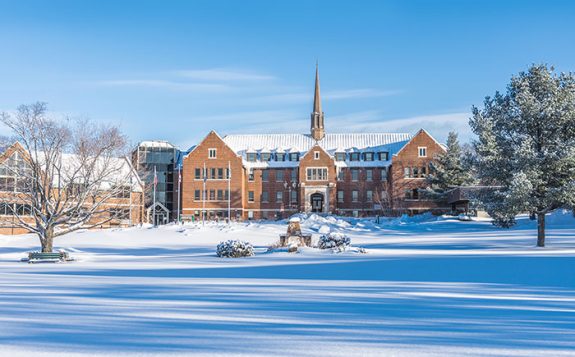Dr. Michael John DiSanto of the English Department has devoted the majority of his academic career to the lives and works of literary luminaries Joseph Conrad and D. H. Lawrence. However, a conversation in the fall of 2009 with his undergraduate mentor, Dr. Brian Crick, inspired him to study George Whalley, a neglected Canadian icon of the twentieth century. Since then, DiSanto has spent his time working to highlight the life of the decorated war veteran, literary scholar, translator, biographer, talented amateur pianist, and writer for CBC radio.
DiSanto first became aware of Whalley as an undergraduate. “I first encountered Whalley when I was an undergraduate student at Brock University. Very likely it was in my third year. I was taking many courses from my professor Brian Crick,” he begins. “He gave me a book of Whalley’s essays to read and I did [but] I didn’t completely grasp or understand it at the time. I wasn’t ready for it. I was too young.”
Flash forward three years later: while at Dalhousie University, completing his PhD dissertation on Conrad, DiSanto revisited Whalley’s book, only this time, he made better sense of his arguments, ideas, and criticism. DiSanto’s dissertation, and later his book Under Conrad’s Eyes: The Novel as Criticism (McGill-Queen’s UP, 2009), became heavily influenced by Whalley. “Whalley had an important place, especially in the introduction.”
Moving his attention from Conrad to Whalley was a natural transition for DiSanto. Both were avid seamen, enjoyed their time on the open seas, and have similar ideas about storytelling, writing, and language. “There is quite a lot of overlap between the two. I also think the time I spent studying Conrad has better prepared me to understand Whalley and appreciate his life and the breadth of his work.”
A trip to Queen’s University Archives in the spring of 2010 aroused more interest in DiSanto. With over 10.3 metres of shelf space dedicated to the George Whalley collection, DiSanto knew a fascinating and forgotten life lived within the boxes on the shelf, waiting to be told.
From there, he began corresponding with Whalley’s wife, Elizabeth Whalley. He had the opportunity to meet her, before she passed away in 2013. “Over three years, we sent letters. I visited with her twice. On the first visit, we spent much time talking about what I would like to do. I had asked her if I could publish a collection of his poetry, a new collection of his essays, a collection of his letters, and a biography. Sometime after I left, she sent me a letter giving me permission. We spoke much about their life together. On the same trip I met Whalley’s youngest daughter Emily. And then I met the other two Whalley children, Katharine and Christopher, soon after.”
Now six years into the project, DiSanto has become thoroughly versed in Whalley’s life and works and is the leading scholar on Whalley. With the help of E-Services Librarian Robin Isard, he has published an extensive website, georgewhalley.ca, which includes a brief documentary of Whalley’s life, photographs, a timeline, audio recordings, and selections of Whalley’s original prose and poetry. The website is just one of the many publications being created by DiSanto to help entrench and memorialize Whalley’s place in Canadian history.
Whalley’s literary thinking is one of the many reasons DiSanto has set out to make Whalley a household name. “We readily recall some people from the twentieth century. Many of these people are very much of their time. Their ways of thinking are of the period rather than having a quality that may transcend the time. It seems to me that Whalley’s thinking is of that kind and that’s one of the reasons why he has fallen out of view. These other people receive a great deal of attention because they fit. I think Whalley doesn’t receive attention because he didn’t fit. In his essays especially, his thinking is part of a tradition that reaches as far back as Samuel Johnson in the eighteenth-century and continues through some of the writers of the nineteenth-century and the beginning of the twentieth. Whalley is a legend among those who knew him, but ought to be better known across the nation.”
But it’s not just his thinking. DiSanto also identifies Whalley’s involvement in World War II as extraordinary and needing to be recognized, and he hopes to one day make Whalley’s involvement known through a documentary film. During the Second World War, Whalley was an officer in the Royal Navy and later the Canadian Royal Navy, serving on destroyers. His first placement was on the HMS Tartar and he was involved in sinking the German battleship Bismarck, one of the most important engagements in the Atlantic. The day following that engagement, he bravely acted to save sailors from the stricken HMS Mashona, which was hit by German bombers and sinking. “English sailors were in the water. Whalley dove in, against naval rules, with a lifeline but without a life jacket… He was able to save one of the three sailors. One was already dead and the other died before he could get him back to the ship. For that bravery and courage he was awarded a Royal Humane Society Medal.”
His later involvement in the Royal Navy is largely shrouded in secrecy. Whalley was reassigned to the Naval Intelligence Division in London, England where he was tasked with planning and implementing the landing and retrieving of secret agents in Europe and designing a new surf boat. “The boat the Royal Navy was using was a design about 200 years old and the secret agents that were sent to Europe weren’t coming back. The navy couldn’t figure out what was going on. Whalley and some other officers went out to test the boats and found out that the waves were capsizing them so these secret agents were drowning. He designed a new boat that was used for the remainder of the war and probably for many years afterwards. He wrote a book on this for the Royal Navy.”
But even more impressive was Whalley’s creation of an acoustic beacon, called the FH 830. “This beacon allowed surface ships to navigate with pinpoint accuracy. They could be exactly where they needed to be for the amphibious landings during the invasions of Siciliy and Normandy. That’s a story that needs to be told. Canadians don’t know.” Though a historian recounted this impressive invention, credit wasn’t given to Whalley.
DiSanto plans to recount Whalley’s life in a biography. The work blurs the boundaries between the studies of History and English, which means DiSanto’s work doesn’t readily fit in just one category, but indeed is interdisciplinary. And Whalley doesn’t fit into just one category, as he was a writer, broadcaster, musician, teacher, officer, pioneer in the use of computers for literary studies, and more. He was, in many ways, a Canadian Renaissance man.
To bring new attention to Whalley, DiSanto co-organized a conference to honour the centenary of his birth at Queen’s University, 24-25 July 2015. A volume of proceedings entitled Awake to Love and Beauty, which contains writings by scholars and some people who knew Whalley, including notable Canadian writers Michael Ondaatje and Elizabeth Hay, will appear in the fall 2016.
DiSanto recently published Whalley’s poems, titled The Complete Poems of George Whalley (McGill-Queen’s UP, 2016). Many of Whalley’s poems were written during his time in the war or in its immediate aftermath and have never been read or seen by the public. “We ought to be studying these. He is the foremost Canadian poet of the Second World War. His poems are rich.” With Alana Fletcher and Robin Isard, DiSanto has co-edited a digital edition of a selection of Whalley’s poetry manuscripts and typescripts that will allow readers to explore Whalley’s process of writing. It will be published in September 2016.
He also plans to publish a collection of his letters. To date, DiSanto, along with his team of dedicated research assistants and interns funded by SSHRC (Social Sciences and Humanities Research Council of Canada) and NOHFC (Northern Ontario Heritage Fund Corporation) have transcribed over 3,000 letters, not even half of the entire collection. “He spent much time writing letters, not just professional, but letters to friends and family also.” Behind the Whalley website is an archival database in which DiSanto and the assistants are collecting digital images and transcriptions of all of Whalley’s extant writings, including unpublished documents and letters, from public and private collections. This work is pursued in collaboration with Queen’s University Archives and Algoma’s Engracia De Jesus Matias Archives and Special Collections.
DiSanto is unsure when he will be able to wrap up his work on Whalley. “There are many, many years ahead of me. I’m not sure if I’ll really ever be done with Whalley. When he becomes widely recognized, then maybe I’ll be done. Until then, I’m trying to make his legend, of which only a few are aware, a story that is a well-known part of Canada’s history.”
Share Article




